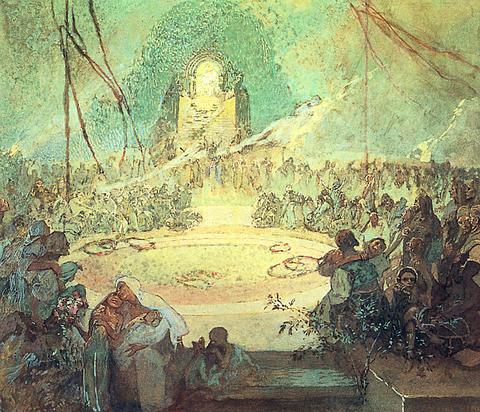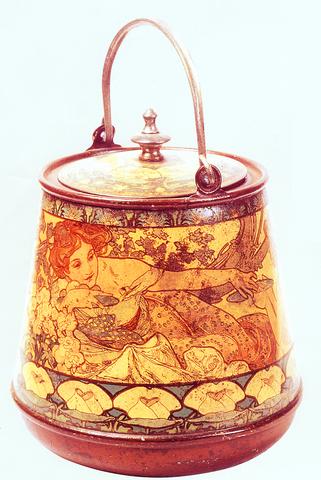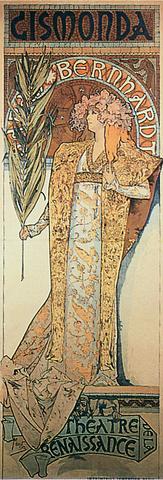Natural colors, asymmetrical lines, elaborate ornamental elements and repeated motifs of flowers, tendrils, and the flowing hair and the curvaceous figure of a female are known today as the characteristics of "Art Nouveau," a worldwide movement of the late 19th and early 20th centuries. Long before the term was coined around 1895 by art critics in Belgium, these elaborate decorative elements were known as "Le style Mucha," refering to the groundbreaking paintings of Alphonse Mucha.
So it's only appropriate that for the first large-scale exhibition about the Art Nouveau movement, the National Museum of History has organized Alphonse Mucha -- The Splendor of Art Nouveau.

PHOTO COURTESY OF NMH
The comprehensive show of 244 exhibits includes sketches, documents, and product designs, as well as Mucha's well-known posters and some rare items. Some of these are on show outside of the Czech Republic, Mucha's home country, for the first time.

PHOTO COURTESY OF NMH
The inspiration derived from nature and influence by the British arts and craft movement particular to Art Nouveau was prevalent throughout Europe and North America. British llustrators Aubrey Beardsley and Walter Crane, Austrian painter Gustav Klimt, French jewellery designer Rene Lalique, Belgian architects Henry van de Velde and Victor Horta, Spanish architect Antonio Gaude, American glassware designer Louis Tiffany and architect Louis Sullivan were all important figures in the movement.
This was at the height of European colonial expansion, when Western European countries ruled most of Asia, Africa and South America while urbanization and economic liberalization were the catchwords at home. Affluence had prompted these artists to spare no effort in making daily-life products exquisite works of art. Contact with distant countries inspired them to incorporate foreign styles, resulting in exotic details of the works.

PHOTO COURTESY OF NMH
Mucha was born in 1860 in the quiet Czech town of Ivancice, less than 20km from the city of Brno. He resolved to become a painter in his late teens after he realized that the art he marveled at in the local churches was actually made by humans.
Mucha began his painting career in 1887 in the art hub of Paris. For five years, he eked out a living drawing illustrations for magazines and gave art lessons.
In 1895 came the turning point in Mucha's life. As all high-profile painters were on Christmas holidays, the obscure Mucha was commissioned to make a poster of Sarah Bernhardt, one of the greatest actresses of the time. Defying the then-current fashion of bright colors and angular shapes, the near-life-size design in curving patterns and natural colors made him an overnight success. He soon won a six-year contract from Bernhardt to design posters, sets and costumes for her plays. Gismonda, the first poster and the equally esteemed Medee are on show.
Mucha's idea to share his designs and paintings with large numbers of people by applying them to functional objects was part of a larger trend to utilize art as decoration. In addition to his work for Bernhardt, Mucha created many graphics, posters, calendars, illustrations and decorative panels for a print shop. The Zodiac, a calender design widely circulated for years, and the decorative panel series of Design for the Arts are among the exhibits.
A large area of the gallery is devoted to Mucha's paintings, which are not quite a well known, such as the solemn Star and Siberia and the dreamy Madonna of the Lilies.
All his life, Mucha remained a patriot of his Czech homeland. Uncommissioned, he returned to Czechslovakia to work on The Slav Epic, a series of paintings on the themes of Slav traditions and history. Including The Introduction of the Slavonic Liturgy and The Abolition of Serfdom, the series took Mucha 18 years to complete. When he donated the 20 large-scale canvasses to the city of Prague in 1928, 10 years after World War I, geopolitics had changed so dramatically that his gift went down coldly with the city government, which did not exhibit them as Mucha had wished.
By the time Germany invaded Czechoslovakia in 1939, Mucha's art was no longer considered "new" by critics but he remained influential enough to be among the first people arrested by the Gestapo. He died soon afterwards.
Although Mucha paid tribute to his Slavic origin in his paintings throughout his 60-year painting career, he is far better acclaimed for creating art for mass consumption, and no less for the long wavy-haired female figures with a sensuous physique and religious looks. The "Muchaesque" women have continued to intrigue art lovers as much as Gustav Klimt's equally sensuous figures.
In addition to most of Mucha's important paintings and designs, his photographs and pastel works are also on show to offer a panorama of Mucha's creative endeavors.
What: Alphonse Mucha -- The Splendor of Art Nouveau
Where: National Museum of History, 49 Nanhai Rd., Taipei
When: through Nov. 5

On April 26, The Lancet published a letter from two doctors at Taichung-based China Medical University Hospital (CMUH) warning that “Taiwan’s Health Care System is on the Brink of Collapse.” The authors said that “Years of policy inaction and mismanagement of resources have led to the National Health Insurance system operating under unsustainable conditions.” The pushback was immediate. Errors in the paper were quickly identified and publicized, to discredit the authors (the hospital apologized). CNA reported that CMUH said the letter described Taiwan in 2021 as having 62 nurses per 10,000 people, when the correct number was 78 nurses per 10,000

As we live longer, our risk of cognitive impairment is increasing. How can we delay the onset of symptoms? Do we have to give up every indulgence or can small changes make a difference? We asked neurologists for tips on how to keep our brains healthy for life. TAKE CARE OF YOUR HEALTH “All of the sensible things that apply to bodily health apply to brain health,” says Suzanne O’Sullivan, a consultant in neurology at the National Hospital for Neurology and Neurosurgery in London, and the author of The Age of Diagnosis. “When you’re 20, you can get away with absolute

May 5 to May 11 What started out as friction between Taiwanese students at Taichung First High School and a Japanese head cook escalated dramatically over the first two weeks of May 1927. It began on April 30 when the cook’s wife knew that lotus starch used in that night’s dinner had rat feces in it, but failed to inform staff until the meal was already prepared. The students believed that her silence was intentional, and filed a complaint. The school’s Japanese administrators sided with the cook’s family, dismissing the students as troublemakers and clamping down on their freedoms — with

As Donald Trump’s executive order in March led to the shuttering of Voice of America (VOA) — the global broadcaster whose roots date back to the fight against Nazi propaganda — he quickly attracted support from figures not used to aligning themselves with any US administration. Trump had ordered the US Agency for Global Media, the federal agency that funds VOA and other groups promoting independent journalism overseas, to be “eliminated to the maximum extent consistent with applicable law.” The decision suddenly halted programming in 49 languages to more than 425 million people. In Moscow, Margarita Simonyan, the hardline editor-in-chief of the